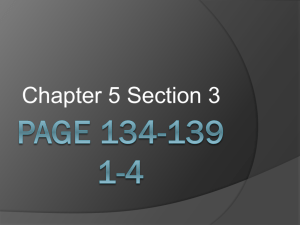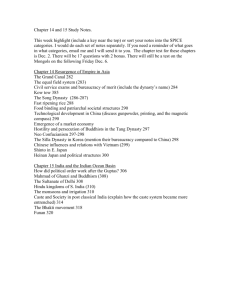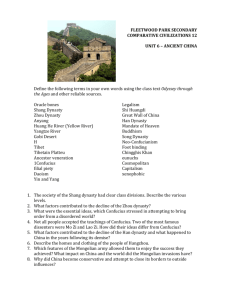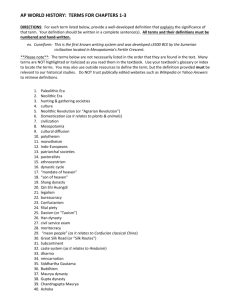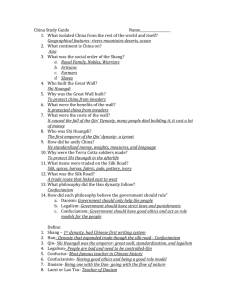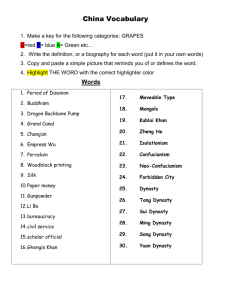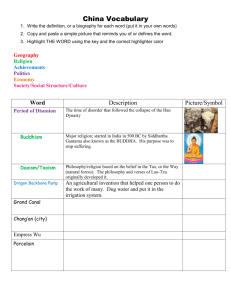ABE China
advertisement
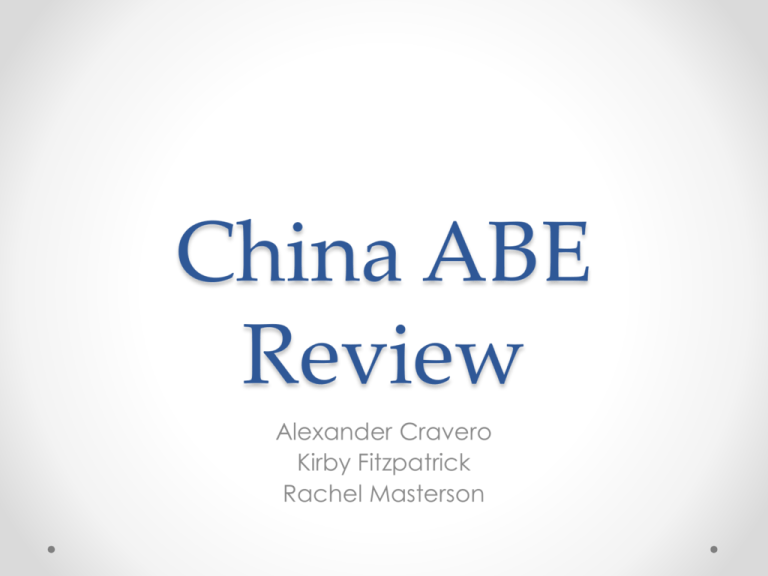
China ABE Review Alexander Cravero Kirby Fitzpatrick Rachel Masterson Lady Feng and the Bear Admonitions of the Imperial Instructress Lady Feng – Gender and Narrative • Lady Feng puts herself between a bear and her husband (shows courage) • Bravery • Handscroll from the Han dynasty Soldiers of Shi Huangdi Soldiers of Shi Huangdi – Authority and Power, Violence, Propoganda • • • • • Terra Cotta 210 BCE must be able to date! Qin Dynasty Shi Huangdi buried in liquid mercury Set up to protect Shi Huangdi’s grave Rubbing of a stone relief; Wu family shrine Rubbing of a stone relief; Wu family shrine • • • • Han Dynasty Yi spares China from disaster Ink rubbing Family, narrative Meeting of the Two Buddhas Meeting of the Two Buddhas • Northern Wei Dynasty, 518, Gilded Bronze, 11” • The meeting only takes place when the lotus sermon is being preached • Prabhutaratna (Buddha thats achieved Nirvana) on the left and Shakyamuni (Buddha that hasn’t achieved Nirvana) on the right • The nimbuses are lakshanas • Religion, Narrative, Authority and Power Set of Bells Set of Bells • Shang, Tomb of Marquis Yi of Zeng • 433 BCE, Bronze • There is a taotie on each of the bells (a symbol that could be heaven & earth and could be compared to the axis mundi) • Each bell makes two tones • Recreation, Religion, Zhou Bi Disk Zhou Bi Disk • • • • • • Jade 6” Symbol for power – dragons Bi refers to the shape Shows unification between the Earth and cosmos Used sand to carve it out Religion, authority and power, statuary conventions Camel Carrying a Group of Musicians Camel Carrying a group of Musicians • • • • • Tang, 8th century, Earthenware and glaze, 26” Showing people in their daily lives Silk Road interactions Appear to be Middle Eastern – beards Social class, narrative, trade and relations Seated Guanyin Bodhisattva Seated Guanyin Bodhisattva • • • • • • 10th-12th cent, wood with paint and gold Bodhisattva of infinite compassion Foot is on a lotus Inviting pose Often thought of as female Gender, religion, narrative Bodhisattva Manjushri as Tikshna-Manjushri Bodhisattva Manjushri as Tikshna-Manjushri • • • • Ming dynasty, Yongle period Gilt bronze, lost-wax casting Notice the facial expression Religion, statuary conventions, gender/human body The Forbidden City • Three nested cities built in the Ming Dynasty for Emperor Yongle. All commoners and foreigners were forbidden to enter without special permission. Also known as the Imperial City. • Architecture • Power/authority Noon Gate • Only one of the Ten enterances to The Forbidden City. Seperated into five bridges, the largest center bridge in the center was for the Emperor and his Family. Often the site of political announcements and decrees. Two stone seals on the side of the road read "Tilt your hat and dismount". • Architecture • Power/authority Guan Yu Captures General Pang De by. Shang Xi • Shang Xi • Hanging Scroll • • Ink and Color on Silk Historical Painting • A depiction of Guan Yu capturing General Pang De during the battle of Changban. Comissioned by Guan Yu. • Narrative, power/authority Hall of Supreme Harmony • The Largest and most important building in the forbidden city, contains the throne room. Built in 1406 it was constructed on the central axis of the forbidden city, often referred to as the heart of the city. Often Grandest ceremonies would be held here. A great symbol of Imperial Power • Architecture • Authority/power Jingdezhen Porcelain Jingdezhen Porcelain • By the Yuan Dynasty, Chinese potters had extended their mastery to fully developed porcelains. This tall temple vase from Jingdezhen kilns, which became the official source of porcelains for the court. It is one of the earliest dated examples of fine porcelain with cobalt-blue underglaze decoration. It has symbols of phoenixes and dragons that represent the donors high status or invoke prosperity blessings. • Power/authority, statuary conventions Landscape by Shitao Landscape by Shitao • Information: Leaf from An Album of Landscapes, Qing, 1700, ink and color on paper, 9.5"x11" • The pictures shows a monk sitting in a small hut. He is looking out at the mountains, which are restless. The dots represent vegetation. The vegetations and rocks seem alive. The rocks and vegetation are appearing to swallow the monk. This represents Shitao's belief that the world had become chaotic under Manchu rule during the Qing Dynasty. • Narrative, politics Lofty Mountain Lu Lofty Mountain Lu Shen Zhou, Ming Dynasty Hanging School, Ink on paper Famous Landscape Painting Writing describes Taoism and the teacher-student relationship. • Narrative, religion, lifestyle • • • • Zhao Mengfu/Autumn Colors on the Qiao and Hua Mountains • • • Zhao Mengfu, a descendant of the first song emperor, was skilled in both calligraphy and poetry. He was also a renown painter of horses, landscapes, and other subjects. One of his most famous works is a handscroll called Autumn Colors on the Qiao and Hua Mountains. (1296- ink and color on paper) He painted this for his friend that was from the Shangdog Providence and it is supposed to depict the landscape there. The mountains and trees are not painted in the usual naturalism of Zhang, they are more archaic of the Tang Dynasty. It is a literati painting with subtle colors and unassuming brushwork. Nature, style

